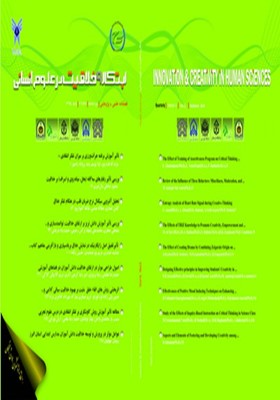Study the effects of Inquiry-based Instruction on critical thinking in science class
Subject Areas : Psychological creativity-logy
Mosayeb Yar Mohammadi vasel
1
*
![]() ,
Behnaz Noshadi
2
,
Hamid Reza Maghami
3
,
Arash Bahrami
4
,
Behnaz Noshadi
2
,
Hamid Reza Maghami
3
,
Arash Bahrami
4
1 - دانشیار دانشگاه بوعلی سینا، گروه روانشناسی، همدان، ایران(نویسندۀ مسئول)
2 - کارشناسی ارشد روانشناسی تربیتی دانشگاه آزاد اسلامی واحد همدان، ایران
3 - عضو هیأت علمی دانشگاه علامه طباطبائی، تهران، ایران
4 - کارشناسی ارشد روانشناسی تربیتی دانشگاه بوعلی سینا، همدان، ایران
Keywords: critical thinking, teaching method, Inquiry-based Instruction,
Abstract :
Purpose: Critical thinking requires that change the thought ,exploring and postulate of students. So the purpose of this research is that Study the effects of Inquiry-based Instruction on critical thinking of students. Method: Research method was quasi-experimental with pretest-posttest design with an experimental group and a control group. The population of this study consisted of all girl students in fifth grade in hamedan city in 2014. Available sampling method was used in this study, 30 students were selected as subjects of research and perch 15 subjects in the control group and 15 subjects in the experimental group by random sampling. The instrument used in this study was California critical thinking questionnaire. The Inquiry-based Instruction was presented by the investigator in 20 sessions of 45 minutes for experimental group. Research data were analyzed by using covariance analysis. Findings: The findings showed that there was significant difference between level of critical thinking of experimental group and control group in pretest and posttest. So Inquiry-based Instruction in science class had a positive effect on students’ critical thinking. Conclusions: The results showed that Inquiry-based Instruction reiforce critical thinking of students in science class, so to the teachers of this lesson is recommended that attention to role of teaching to Inquiry-based Instruction to enhance their critical thinking.
آقازاده، محرم. (1388). روش های نوین تدریس، تهران: آبیژ.
ﺟﺎوﯾﺪی ﮐﻼﺗﻪ ﺟﻌﻔﺮآﺑﺎدی، ﻃﺎﻫﺮه؛ ﻋﺒﺪﻟﯽ، اﻓﺴﺎﻧﻪ. (1390). مهارت های تفکر انتقادی دانشجویان مقطع کارشناسی دانشگاه فردوسی مشهد. مطالعات آموزشی و روانشناسی،11 (2)، 20-103.
حسن بیگی، علی. (1382). بررسی تأثیر روش آموزش کاوشگری بر موفقیت تحصیلی و بهبود مهارت های اجتماعی دانش آموزان دختر دوم متوسطه شهر اراک در سال تحصیلی 81-1382، اداره کل آموزش و پرورش استان مرکزی.
کیارسی، سمیه. (1387). مقایسه اثربخشی روش تدریس کاوشگری با روش تدریس همیاری بر پیشرفت تحصیلی و مهارتهای اجتماعی دانش آموزان دختر در درس علوم تجربی سال پنجم ابتدایی شهر دزفول، پایان نامه کارشناسی ارشد. دانشگاه علامه طباطبایی.
هارلن، وین.(1391). نگرشی نو بر آموزش علوم تجربی، ترجمه: شاهده سعیدی، تهران: نشر مدرسه
Abrams, E., Southerland, S. A., & Silva, P. C. (2007). Inquiry in the classroom: Realities and opportunities (PB) (Contemporary Research in Education). UK: Information Age Publishing.
Arbaugh, J. B. (2007). An empirical verification of the community of inquiry framework. Journal of Asynchronous Learning Networks, 11(1), 73–85.
Chambers, Sharon M., Hardy, James C (2005). Length of Time in Student Teaching: Effects on Classroom Control Orientation and Self-Efficacy Beliefs, Educational Research Quarterly, 28(3), 3-9.
Facione, P. A. (2000) "The Disposition toward Critical Thinking: Its Character, Measurement, and Relationship to Critical Thinking Skill". Informal Logic, 20(1).
Halpern, D.F., & Roediger, H.L., & Sternberg, R.J. (2007). The nature and nurture of critical thinking. Critical thinking in psychology. Cambridge, NY: Cambridge university press, pp.1-14.
Heid, K., Estabrook, M., & Nostrant, C. (2009). Dancing with line: Inquiry, democracy, and aesthetic development as anapproach to art education. International Journal of Education & the Arts, 10 (3), 1-21.
Holmes, T. & Hoffman, P. S. (2000). Elicit, engage, experience, explore: Discovery learning in library instruction. Reference Services Review, 28 (4), 313-322.
Joyce B, Weil M, Calhoun E. (2001). Teaching methods 200. Translated by Mohamad reza behrangi, Tehran: kamal Tarbiat poblication.
Landsman, R. E. (2005). RIP-ing through scientific inquiry: Critical thinking.USA: ANOVA Science Publishing.
Meyers BE, Dyer JE. (2006). the influence of student learning style on critical thinking skill. Journal of Agricultural Education; 2006:47(1): 43-52.
Meyers, C. (1986). Teaching students to think critically. California: Bass; 1991.
Papert, S. (2000). What’s the big idea? Toward a pedagogy of idea power. IBM Systems Journal. 39(3/4), 720-729.
Reeve, J., & Halusic, M. (2009). How k-12teachers can put self-determination theory principles into practice. Theory and Research in Education, 7, 145-154.
Tapper, J., (2004). Student perceptions of how critical thinking is embedded in a degree program. Higher education research & Development. Vol.23, No. 2.
Thomas. J. and et al (2006). Teaching Courses on line. Journal of Review of educational research, 76(1) 93-135.
Winnipeg, M. B. (2006). Literacy with ICT and inquiry processes across the curriculum: A continuum model. Manitoba Education: Citizenship and Youth, 11.
Ricketts, J. C. (2003). The efficacy of leadership development, critical thinking dispositions, and student academic performance on the critical thinking skills of selected youth leaders. Unpublished doctoral dissertation, University of Florida, Gainesville. Available at: http: //etd. fcla. edu/ UF/ UFE0000777/ ricketts_ j. pdf.
_||_

